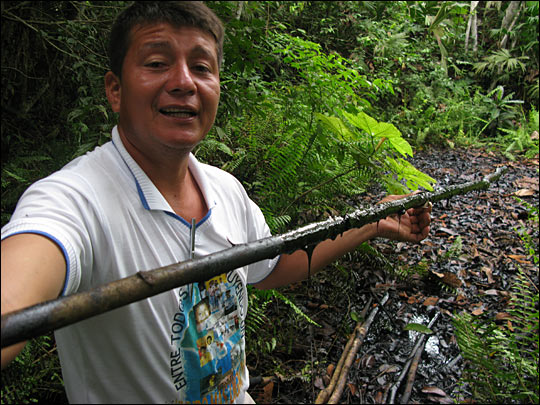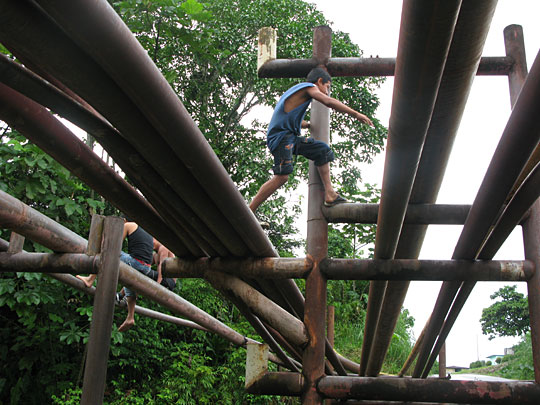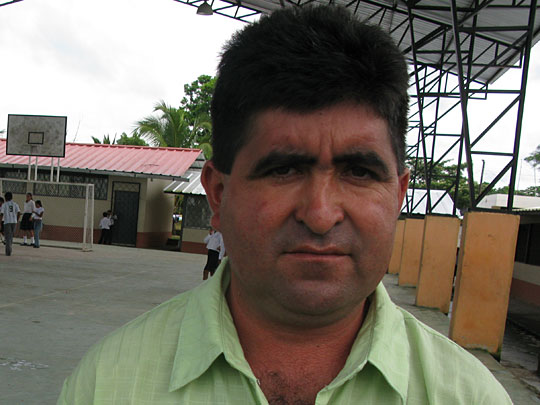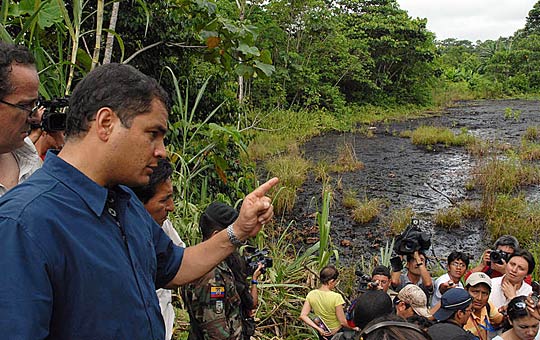Ecuador adopted the US dollar in 2000 - Gas prices have been the same since Jan. 2003. Subsidized by the government.
The following article is the best one I have found on Ecuador's 12 year economical recovery:
The following article is the best one I have found on Ecuador's 12 year economical recovery:
Could Ecuador be the most radical and exciting place on Earth?
A decade ago, Ecuador was a banana republic, an economic basket case. Today, it has much to teach the rest of the worldEcuador must be one of the most exciting places on Earth right now, in terms of working towards a new development paradigm. It shows how much can be achieved with political will, even in uncertain economic times.Just 10 years ago, Ecuador was more or less a basket case, a quintessential "banana republic" (it happens to be the world's largest exporter of bananas), characterised by political instability, inequality, a poorly-performing economy, and the ever-looming impact of the US on its domestic politics.In 2000, in response to hyperinflation and balance of payments problems, the government Dollarised the economy, replacing the Sucre with the US currency as legal tender. This subdued inflation, but it did nothing to address the core economic problems, and further constrained the domestic policy space.A major turning point came with the election of the economist Rafael Correa as president. After taking over in January 2007, his government ushered in a series of changes, based on a new constitution (the country's 20th, approved in 2008) that was itself mandated by a popular referendum. A hallmark of the changes that have occurred since then is that major policies have first been put through the referendum process. This has given the government the political ability to take on major vested interests and powerful lobbies.The government is now the most stable in recent times and will soon become the longest serving in Ecuador's tumultuous history. The president's approval ratings are well over 70%. All this is due to the reorientation of the government's approach, made possible by a constitution remarkable for its recognition of human rights and the rights of nature, and its acceptance of plurality and cultural diversity.Consider just some economic changes brought about in the past four years, beginning with the renegotiation of oil contracts with multinational companies. Ecuador is an oil exporter, but had benefited relatively little from this because of the high shares of oil sales that went to foreign oil companies. A new law in July 2010 dramatically changed the terms, increasing the government's share from 13% to 87% of gross oil revenues.Seven of the 16 foreign oil companies decided to pull out, and their fields were taken over by state-run companies. But the others stayed on and, as a result, state revenues increased by $870m in 2011.Second, and possibly even more impressively, the government managed a dramatic increase in direct tax receipts. In fact, this has been even more important in revenue terms than oil receipts. Direct taxes (mainly corporation taxes) increased from around 35% of total taxes in 2006 to more than 40% in 2011. This was largely because of better enforcement, since the nexus between big business and the public tax administration was broken.Third, these increased government revenues were put to good use in infrastructure investment and social spending. Ecuador now has the highest proportion of public investment to GDP (10%) in Latin America and the Caribbean. In addition, social spending has doubled since 2006. This has enabled real progress towards the constitutional goals of free education at all levels, and access to free health care for all citizens. Significant increases in public housing have followed the constitution's affirmation of the right of all citizens to dignified housing with proper amenities.There are numerous other measures: expanding direct public employment; increasing minimum wages which is now $320 a month and legally enforcing social security provision for all workers; diversifying the economy to reduce dependence on oil exports, and diversifying trading partners to reduce dependence on the US; enlarging public banking operations to reach more small and medium entrepreneurs; auditing external debt to reduce debt service payments; and abandoning unfair bilateral investment agreements. Other efforts include reform of the justice system.
POLLUTION OF THE AMAZON
Pipelines run through Amazon villages
Oil deposits left over from drilling that were never cleaned up
Rain Forest Residents, Texaco Face Off In Ecuador
Donald Moncayo is an activist who works with the poor farmers and Indian plaintiffs who are suing Chevron Corp., which bought Texaco in 2001, over environmental damage in Ecuador's rain forest. Here, Moncayo shows the alleged legacy of Texaco's drilling: oily pools of toxic waste.

Donald Moncayo is an activist who works with the poor farmers and Indian plaintiffs who are suing Chevron Corp., which bought Texaco in 2001, over environmental damage in Ecuador's rain forest. Here, Moncayo shows the alleged legacy of Texaco's drilling: oily pools of toxic waste.
In nearly three decades in Ecuador, Texaco built the country's oil industry from scratch — and grids of pipes and other infrastructure are found across a swath of jungle. Children now use the pipelines as makeshift jungle gyms.

Wilmo Moreta, a schoolteacher, recalls bathing in the Napo River, drinking from it and using its water for cooking. Now, he says, he suffers from multiple health problems, and he blames Texaco for polluting the river.

Ecuadorian President Rafael Correa speaks with people during an April 2007 visit to Los Sachas, an area affected by oil drilling. Correa accused Texaco of causing irreversible ecological damage to the region.

April 30, 2009
A judge is preparing to render a decision in a long-running, multi billion-dollar lawsuit filed by residents of Ecuador's Amazonian rain forest against Texaco for fouling their land.
But a court-appointed expert agrees with many of the plaintiffs' charges and has assessed damages at $27 billion. Now, a judge in the small town of Lago Agrio, says he hopes to have a decision before the end of the year.
Plaintiffs: A Legacy Of Pollution
Donald Moncayo, an activist who works with the poor farmers and Indian plaintiffs in the case, takes visitors on what he calls "toxic tours."
After tramping through the jungle, Moncayo reaches a huge pool of oily sludge and sticks a long pole into the muck. He says this is a legacy of Texaco's quarter-century in Ecuador: pollution that affects tens of thousands of people who bathe and drink from rain forest waterways.
He says mud and other waste produced by drilling and production were dumped in the pit, and the toxins here and in hundreds of similar unlined pits leaked into the ground. A court-appointed geologist, Richard Cabrera, and his 14-member scientific team found barium, lead and other heavy metals in those pits.
Chevron disputes Cabrera's findings. The company wants his report thrown out, saying he is biased toward the plaintiffs.
All this happened in what was once virgin Amazonian jungle, the world's greatest biosphere and an area that still contains huge oil reserves.
The plaintiffs say Texaco, in 18 years of full-scale production, also dumped chemical waste water from drilling into rivers and that pipeline breaks spilled 17 million gallons of oil.
Pablo Fajardo, a 36-year-old lawyer, leads the plaintiffs' team. He grew up poor in the area; this is his first legal case.
Fajardo says his side has proved there was damage, that Chevron was responsible and that the company should pay.
Defendants: Texaco Acted Legally
Locally, the case has been called the trial of the century, and some of the hearings have been held in the jungle. Chevron does not dispute that pollution exists.
But Chevron lawyer Diego Larrea says it's Petroecuador — the state oil company, which still drills oil in the area — that is responsible for the pollution.
Larrea says Texaco adhered to Ecuadorian law. He also says Ecuador's government released the company of legal responsibility after a three-year cleanup a decade ago.
In the current trial, the plaintiffs charge that Texaco's cleanup was a fraud, and the current government of Ecuador agrees.
The original suit was filed against Texaco in 1993 in a New York court. But Chevron argued that the case be moved to Ecuador, saying Ecuadorian courts were impartial and professional.
In 2003, the trial was moved to a ramshackle court in Lago Agrio, a nondescript, dusty town near Colombia's lawless frontier.
The judge in the case, Juan Nunez, says he feels the pressure on his conscience. And he says he has to carefully consider the arguments both sides have offered — arguments laid out in 145,000 pages of evidence.
Texaco came to Ecuador in 1964. When it left nearly 30 years later, it had extracted 1.5 billion barrels and built Ecuador's oil industry from scratch.
The infrastructure is everywhere. Pipelines run alongside major roads. Pumping stations are located in clearings, carved out of the jungle.
And then there are pools of sludge.
The government says Petroecuador is not blameless. It, too, dumped waste water intro waterways.
But the state oil company's past practices do not absolve Texaco, the government says. Texaco was the primary operator for years and the pollution left behind is close to where people live and where children go to school, the government claims.
Health Problems Abound Among Locals
Wilmo Moreta, a schoolteacher in the town of Shushufindi, says he suffered skin rashes and other ailments when Texaco operated in the area. He says he drank water from the Napo river, bathed in it and used its water for cooking. He now blames oil pollution for his problems.
Cabrera's team, though, goes further, linking 1,401 cancer deaths to oil production and laying most of the blame for the pollution on Texaco.
Chevron has countered Cabrera, the court-appointed geologist, by releasing a battery of studies that show cancer rates in the area are no higher than in other regions of Ecuador.
Chevron Disputes Report Findings
James Craig, a Chevron spokesman, says that the Cabrera report is "flawed in many ways."
"In our view, it's a fraudulent report that we've asked the court to toss out a number of times," he says.
Craig also says the methods Texaco's subsidiary, TexPet, used in Ecuador were common in the United States — and still are. Craig says that includes the use of unlined pits to hold sludge.
"To suggest that somehow TexPet was using obsolete technology or substandard methods at the time is a complete falsehood," he says.
States such as Texas permit unlined pits, but only for temporary use. In such instances, the waste must be disposed of eventually, often by re-injection back into the ground.
Case Wends Its Way Toward Resolution
Ecuadorian President Rafael Correa squarely sides with the plaintiffs. He says Texaco left behind a mess. His government is also prosecuting two Chevron attorneys and seven former government officials who signed off on the cleanup of 167 out of 1000 oil pits in 1998.
Correa says that pools operated by Texaco remain open, with little having been cleaned up.
Craig, the Chevron spokesman, says Correa's comments show the company can't get a fair hearing — even though it was Chevron that originally petitioned to have the case transferred from the U.S. to Ecuador.
"Unfortunately, the case has deteriorated into a judicial farce, with the media circus put on by the plaintiffs on a regular basis, with the political pressure brought to bear on the court, with the government and political interference in this case," he says.
Indeed, Chevron is already talking about a possible appeal should it lose the case.
Meanwhile, in the jungle, residents wonder who will clean up the mess — or compensate them for their health problems.
60-Minute video on Amazon pollution:
http://www.youtube.com/watch?feature=player_detailpage&v=3hMdsxrAyT0
Meanwhile the pollution in the Amazon remains a major health hazard!
60-Minute video on Amazon pollution:
http://www.youtube.com/watch?feature=player_detailpage&v=3hMdsxrAyT0
Meanwhile the pollution in the Amazon remains a major health hazard!
One exciting recent initiative is the Yasuní-ITT biosphere reserve, perhaps the world's first attempt to avoid greenhouse emissions by leaving oil underground. This not only protects the extraordinary biodiversity of the area but also the habitats of its indigenous peoples. The scheme proposes to use ecotourism to make human activity compatible with nature.All this may sound too good to be true, and certainly the process of transformation has only just begun. There are bound to be conflicts with those whose profits and power are threatened, as well as other hurdles along the way. But for those who believe that we are not condemned to the gloomy status quo, and that societies can do things differently, what is happening in Ecuador provides inspiration and even guidance. The rest of the world has much to learn from this ongoing radical experiment.
Cars in Ecuador:
Most of the cars in Ecuador are imported and assembled here. I have spotted more Chevrolet followed by Ford, KIA. Hyundai, Toyota and Nissan plus other makes. Not many Luxury cars here, mostly small economical cars.
I have not seen these cars in the US - most of the cars here are made in Korea, Japan and China. They are assembled in Ecuador.
For example I have seen a few KIA Soul which sell in the US for $17,000 but with Ecuador taxes sell for $22,000 here.
And many more models here not seen in the USA!
Until next time!


















Gary,
ReplyDeleteGreat post thanks for sending it. I really want to bring Nadine down to visit. One more year and I get SS. Have you found any Motorcycles forsale down there.
Larry
Interesting read, Gary. Leaving oil underground is a new one to me. How does that work?
ReplyDeletePaying Ecuador to leave oil underground?
Deleteby Mark Notaras on October 1, 2010
Recently the Government of Ecuador and the United Nations signed a landmark legally binding deal to preserve the country’s oil rich Yasuni National Park.
As part of the pact, economically rich nations will pay this poor equatorial nation a sizeable US$3.6 billion to protect an area of staggering biological diversity. Yasuni, part of the Amazon, is home to several isolated (two of which are uncontacted) indigenous tribes, hundreds of native tree species and dozens of endangered fauna.
This means leaving around 846 million barrels of oil permanently underground in the Ishpingo-Tambococha-Tiputini (ITT) oilfields, avoiding the emission of over 400 million metric tonnes of CO2, according to the government’s Yasuni initiative website.
Compensating for potential resource income forfeited in order to reduce carbon emissions and protect biodiversity is an example of an emerging UN-promoted arrangement known as ‘payment for ecosystem services’
This comment has been removed by a blog administrator.
ReplyDelete